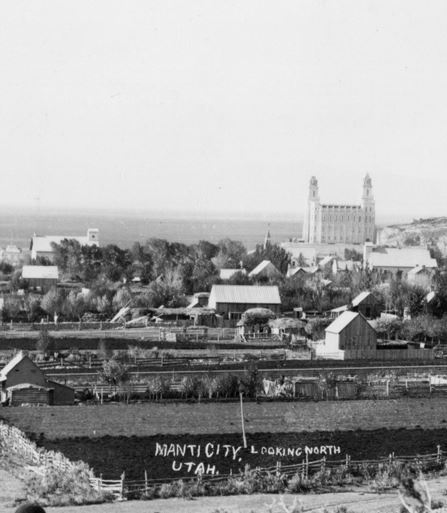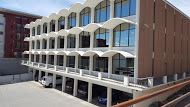Two Utahs: Religious and Secular Landscapes in the Great Basin West
Vernacular Architecture Forum Conference
Salt Lake City, May 31 to June 4, 2017

During the first week of June 2017, Salt Lake City will serve as the host location for the annual conference of the Vernacular Architecture Forum. The 2017 event marks the 30th anniversary of the first VAF conference in Utah, which was held in May of 1987. Dr. Thomas Carter of the University of Utah reprises his role as conference organizer. Sponsors this year include The Church of Jesus Christ of Latter-day Saints, the Utah State Historical Society, the Tanner Humanities Center at the University of Utah, the University of Utah’s College of Architecture and Planning, and the Park City Planning Department. Preservation Utah (formerly Utah Heritage Foundation) is serving as conference planners, with principal funding from the VAF, Zions Bank, and Philip G. McCarthey.
The Salt Lake City conference highlights the process by which the vast interior of the western United States was transformed beginning in the nineteenth century into one of the world’s most distinctive regional landscapes. The story is expressed in the Two Utahs conference title, which acknowledges the central role The Church of Jesus Christ of Latter-day Saints, also referred to as the Mormons or LDS Church, played in the place-making process, while at the same time recognizing the significant contributions of non-Mormon forces. Rather than framing the narrative within a simple Mormon/non-Mormon opposition, we break things down into a more fundamental dialogue with religious and secular forces; both Mormons and non-Mormons, and how they had to find ways of making a living and utilizing, even exploiting the region’s ample natural resources. The real duality in the landscape may be between idealism (religious utopia, Edenic nature, sustainable development) and pragmatism (individual enterprise, outdoor recreation, economic growth). Conference tours have been designed to introduce attendees to the intricacies of the region’s built environment, and to raise questions about how landscapes are constructed, maintained, contested, and changed.
Conference Schedule
Wednesday, May 31st
Opening Reception, The Depot - http://depotslc.com/
Thursday, June 1st


Tour 1: Town and Temple: the Mormon Landscape of Utah’s Sanpete Valley
This tour focuses on nineteenth century Mormon architecture and town planning.
 Tour leaders: Thomas Carter and Peter Goss
Tour leaders: Thomas Carter and Peter Goss
Preview: A preview can be found in Carter’s newest book, Building Zion: The Material World of Mormon Settlement (Minnesota 2015)

Tour 2: Boomtown: From Mining to Skiing in Park City
The way western mining towns have been re-made into recreational meccas (based on skiing) is showcased in this day-long tour in the Wasatch Mountain Range.
Tour leaders: Anne Oliver, SWCA, and Anya Grahn and Hannah Tyler, Park City Planning Department.
Friday, June 2nd

Morning Tour A: Exchange Place and the Gentile City
From early in downtown’s development, Salt Lake City was composed of two distinctive cultural areas. The area on the north, centered on Temple Square, that was owned by the LDS Church, and the Gentile (Non-Mormon) area to the south, along 300 and 400 South Streets, which is the focus of this morning’s tour.
Tour leader: Kirk Huffaker, Preservation Utah.
Preview: For advance reading, see Preservation Utah’s Downtown Walking Tour Guide – Available online here. http://www.utahheritagefoundation.com/tours-and-events/self-guided-tours/item/17-historic-downtown-salt-lake-city#.WFg_nlMrKCo

Morning Tour B: The City Moves East
After 1890, the core residential area of Salt Lake City shifted from the downtown area east along South Temple Street (Brigham Street) and then into the new Avenues subdivision. This tour looks at the architectural implications of the reconfiguration.
Tour leaders: Roger Roper and Cory Jensen, Utah State Historical Society.
Preview: For a preview, see Bim Oliver’s South Temple Street Landmarks: Salt Lake City’s First Historic District, due to be released in January 2017 (The History Press).

Afternoon Tour A: Temple Square
During the afternoon, the LDS Church will open a number of buildings in and around Temple Square, including the Brigham Young’s Beehive and Lion Houses, the Joseph Smith Center (formerly the Hotel Utah—the site of the 1987 VAF conference), Assembly Hall (18xxdate?), the Tabernacle (1865-66??), and the Conference Center (2000, as well as exhibits on the ongoing renovation of the Salt Lake Temple (1893).
Tour leader: Emily Utt, Historic Sites Curator, The Church of Jesus Christ of Latter-day Saints.
Preview: For a preview, see Elwin C. Robison’s Gathering as One: The History of the Mormon Tabernacle in Salt Lake City.

Afternoon Tour B: Light Rail and Re-urbanization
Tour members will ride the TRAX light rail system to the 900 South and Sugar House districts to experience the city’s efforts to revitalize these neighborhoods through tax increment financing, upzoning for higher density, accessible transit options.
Tour leader: Susan Petheram, University of Utah College of Architecture + Planning.
Saturday June 3rd
Conference Paper Sessions, Reception, Annual Business Meeting, and Banquet
Salt Lake City Marriott City Center (Conference Headquarters Hotel)
Sunday June 4th
Optional activities include the following self-guided tours:

Snowbird Mountain Resort
Salt Lake City’s Mid-Century Modern Architecture via the Utah Heritage Walks App – available in the Apple app store and Google Play

Visit The Mighty 5: Utah’s National Parks
Canyonlands National Park, then watching the sunset through an impossibly delicate rock bow in Arches National Park. It means standing nose-to-nose with ancient petroglyphs in Capitol Reef National Park, then lying on your back as a beautiful meteor shower streaks across the Milky Way. It means gazing down at coral-hued rock hoodoos in Bryce Canyon National Park, then gazing upward at the steep walls of slot canyon trails in Zion National Park. It means hiking, river rafting, biking, picnicking, walking, mule riding, exploring and stargazing.
Salt Lake City Marriott City Center available at a discount for VAF conference attendees now through May 5th.
Book your group rate for Vernacular Architecture Forum